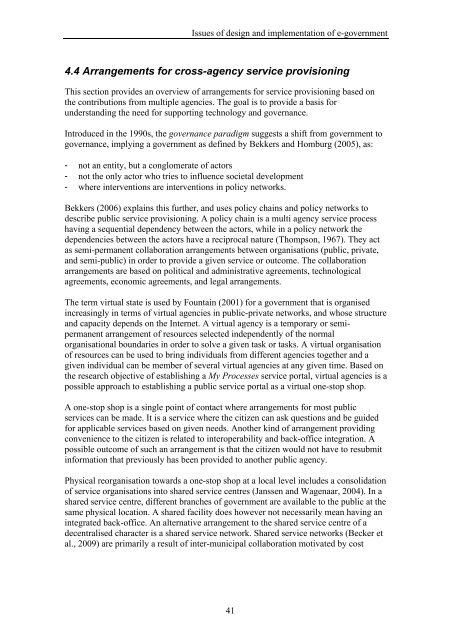Multi-channel provisioning of public services - Department of ...
Multi-channel provisioning of public services - Department of ...
Multi-channel provisioning of public services - Department of ...
You also want an ePaper? Increase the reach of your titles
YUMPU automatically turns print PDFs into web optimized ePapers that Google loves.
Issues <strong>of</strong> design and implementation <strong>of</strong> e-government<br />
4.4 Arrangements for cross-agency service <strong>provisioning</strong><br />
This section provides an overview <strong>of</strong> arrangements for service <strong>provisioning</strong> based on<br />
the contributions from multiple agencies. The goal is to provide a basis for<br />
understanding the need for supporting technology and governance.<br />
Introduced in the 1990s, the governance paradigm suggests a shift from government to<br />
governance, implying a government as defined by Bekkers and Homburg (2005), as:<br />
- not an entity, but a conglomerate <strong>of</strong> actors<br />
- not the only actor who tries to influence societal development<br />
- where interventions are interventions in policy networks.<br />
Bekkers (2006) explains this further, and uses policy chains and policy networks to<br />
describe <strong>public</strong> service <strong>provisioning</strong>. A policy chain is a multi agency service process<br />
having a sequential dependency between the actors, while in a policy network the<br />
dependencies between the actors have a reciprocal nature (Thompson, 1967). They act<br />
as semi-permanent collaboration arrangements between organisations (<strong>public</strong>, private,<br />
and semi-<strong>public</strong>) in order to provide a given service or outcome. The collaboration<br />
arrangements are based on political and administrative agreements, technological<br />
agreements, economic agreements, and legal arrangements.<br />
The term virtual state is used by Fountain (2001) for a government that is organised<br />
increasingly in terms <strong>of</strong> virtual agencies in <strong>public</strong>-private networks, and whose structure<br />
and capacity depends on the Internet. A virtual agency is a temporary or semipermanent<br />
arrangement <strong>of</strong> resources selected independently <strong>of</strong> the normal<br />
organisational boundaries in order to solve a given task or tasks. A virtual organisation<br />
<strong>of</strong> resources can be used to bring individuals from different agencies together and a<br />
given individual can be member <strong>of</strong> several virtual agencies at any given time. Based on<br />
the research objective <strong>of</strong> establishing a My Processes service portal, virtual agencies is a<br />
possible approach to establishing a <strong>public</strong> service portal as a virtual one-stop shop.<br />
A one-stop shop is a single point <strong>of</strong> contact where arrangements for most <strong>public</strong><br />
<strong>services</strong> can be made. It is a service where the citizen can ask questions and be guided<br />
for applicable <strong>services</strong> based on given needs. Another kind <strong>of</strong> arrangement providing<br />
convenience to the citizen is related to interoperability and back-<strong>of</strong>fice integration. A<br />
possible outcome <strong>of</strong> such an arrangement is that the citizen would not have to resubmit<br />
information that previously has been provided to another <strong>public</strong> agency.<br />
Physical reorganisation towards a one-stop shop at a local level includes a consolidation<br />
<strong>of</strong> service organisations into shared service centres (Janssen and Wagenaar, 2004). In a<br />
shared service centre, different branches <strong>of</strong> government are available to the <strong>public</strong> at the<br />
same physical location. A shared facility does however not necessarily mean having an<br />
integrated back-<strong>of</strong>fice. An alternative arrangement to the shared service centre <strong>of</strong> a<br />
decentralised character is a shared service network. Shared service networks (Becker et<br />
al., 2009) are primarily a result <strong>of</strong> inter-municipal collaboration motivated by cost<br />
41
















